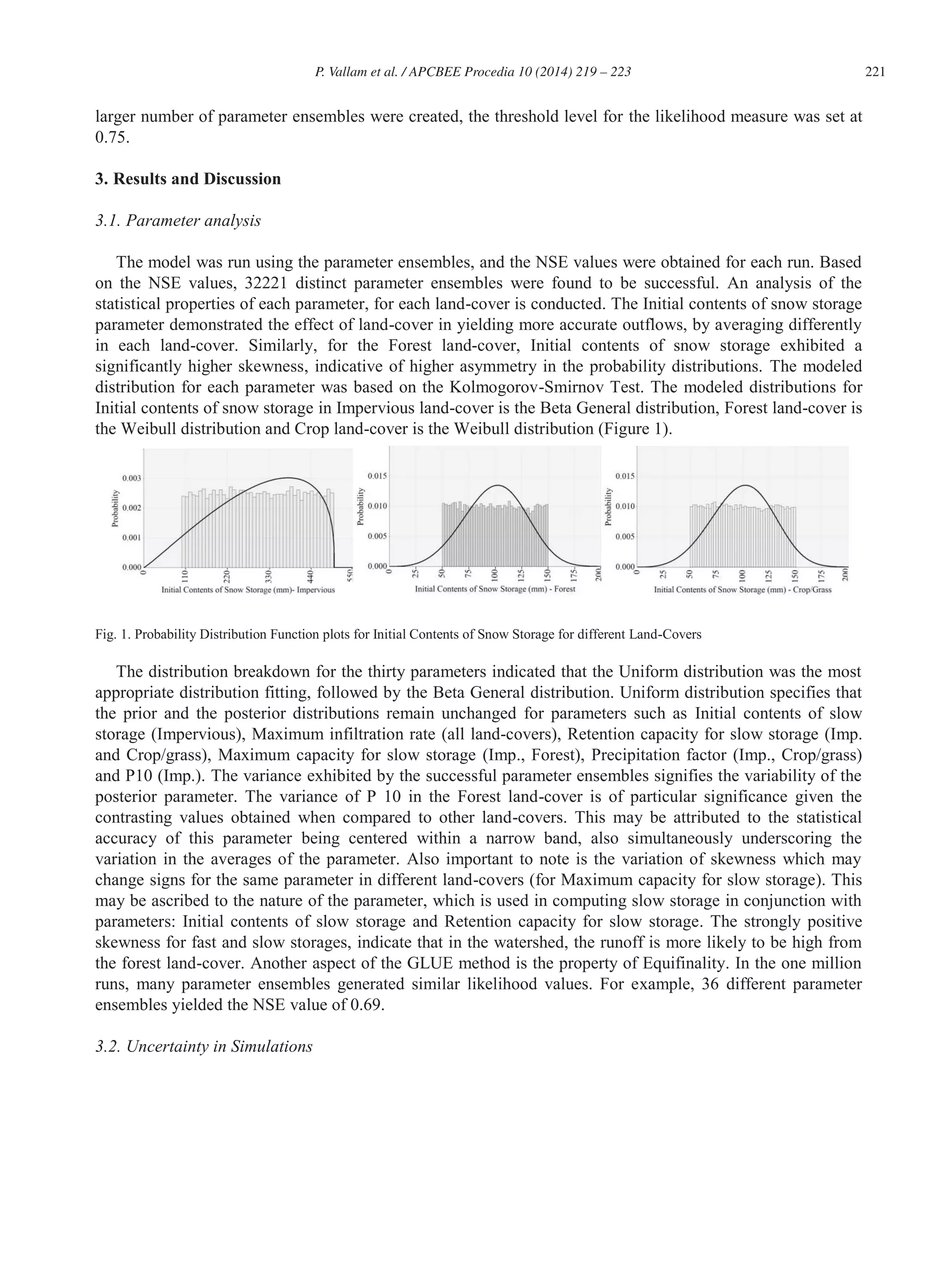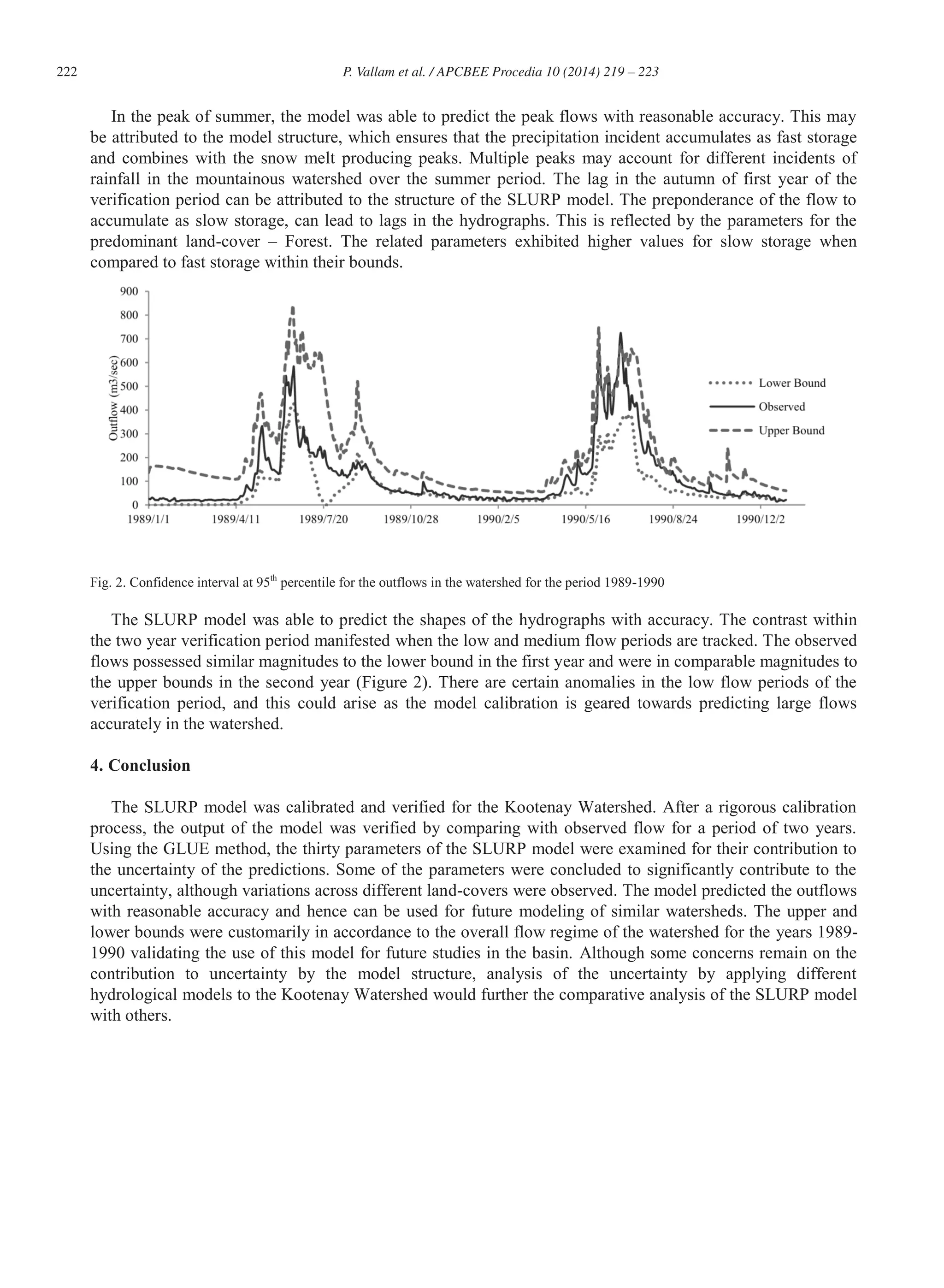This document summarizes a study that used the Generalized Likelihood Uncertainty Estimation (GLUE) method to analyze parametric uncertainty in hydrological modeling of the Kootenay Watershed in Canada. The study used the SLURP hydrological model and analyzed over 1 million parameter combinations using the GLUE method. The results identified distributions for key model parameters and showed variability in parameter averages and distributions between different land cover types within the watershed. This provided insights into parametric uncertainties and improved understanding of hydrological processes in the study area.

![220 P. Vallam et al. / APCBEE Procedia 10 (2014) 219 – 223
diversification in the applications of hydrological models, general analysis of model outputs gains pre-
eminence over improving accuracy for a particular case study. This analysis of model outputs to determine
their uncertainty is performed by using different techniques. Divided broadly into Bayesian based and non-
Bayesian based techniques, the uncertainty in most hydrologic models can be analyzed. In this study, a robust
uncertainty analysis technique, i.e. Generalized Likelihood Uncertainty Estimation (GLUE) method, is used.
2. Methodology and Study Case
The hydrological model employed in this study is the Simple LUmped Reservoir Parametric (SLURP)
model developed by Kite [1]. The SLURP model has been applied for different snow watersheds and has been
determined robust [2], [3]. The technical details of the model can be referred to Kite [1]. To enable a thorough
study of the parametric uncertainty of the SLURP model, the Kootenay Watershed was modeled. The
temperature data and relative humidity data for this particular case study were obtained from CFSR website.
Other flow data and meteorological data at the different stations were obtained from the Hydat database and
the Canada Daily Climate Data. The Kootenay Watershed is divided into three different ASAs and their
characteristics could be found in Kite [1]. The streamflows from the Crossing ASA flow into Canal ASA and
then onto Skookum ASA, which makes Skookum the outlet for the watershed. The calibration period (1979-
1988) was performed using 3653 continuous daily flow data followed by a verification period (1989-1990) for
760 continuous daily outflows at Skookum. The Kootenay Basin is a remote mountainous watershed and has
not seen any significant human settlements during the calibration-verification period. Hence it is assumed that
the land-cover percentages are constant throughout the entire period. No visible major water diversionary
structures were found in the period of study, removing any need to alter the output of the model to reflect this.
The uncertainty analysis method is based on GLUE. It is an Equifinality based method presented by Beven
and Binley [4] using likelihood measures. It has been proven to be robust for uncertainty analysis of different
case studies [5]. This method is a Bayesian-type uncertainty analysis technique which makes use Maximum
Likelihood Estimators to evaluate the performance of different parameter ensembles. The method considers
every parameter ensemble to have equal likelihood to yield sufficiently accurate outputs i.e. flows. The
significant advantage of the GLUE method is its ability to determine parameter uncertainty from all sources:
parameter, model structure and input [6]. Another advantage of the GLUE method is its flexibility and
simplicity which guarantees a wide range of application as evidenced in numerous examples in literatures [6,
7, 8, 9]. Therefore, this methodology which combines GLUE with SLURP, examines the parametric
uncertainty using likelihood estimators, proving to be a novel application of this method. The SLURP manual
by Kite [1] describes the ten most sensitive parameters and their bounds.
In this application of the GLUE method, the Nash Sutcliffe Efficiency (NSE) is utilized as the likelihood
estimator [10]. The NSE determines the magnitude of residual variance when the simulations are compared to
the observed flow. It has been the likelihood estimator for many GLUE studies using other models, including
SWAT [6], Institute of Hydrology Distributed Model [4], ADM model [5], etc. In the absence of a prior
distribution, the uniform distribution was adopted as recommended by previous researchers [6]. The random
values were generated using Matlab software subject to the limits described in Kite [1]. To ensure a rigorous
process of choosing the parameter ensembles, one million parameter ensembles were created. To further
improve the sampling process, Latin Hypercube Sampling Scheme was employed. To account for the three
different land-covers (i.e. Impervious, Forest and Crop/Grass) three different sets of the million ensembles
were created (a total of three million ensembles) for analysis. In the GLUE methodology, the definition of
threshold is subjective. The likelihood measure is accorded a value which each parameter ensemble must
exceed to be considered a physically representative ensemble. Usually, when the NSE is employed as the
likelihood measure, a threshold value of approximately 0.5 has been suggested [6]. However, given that a](https://image.slidesharecdn.com/f5a53e14-b786-4c3f-8f51-6aa5b810aa4e-160128182319/75/APCBEE-2-2048.jpg)


![223P. Vallam et al. / APCBEE Procedia 10 (2014) 219 – 223
Acknowledgments
This research was supported by Singapore’s Ministry of Education (MOE) AcRE Tier 1 Project
(M4010973.030) and Tier 2 Project (M4020182.030).
References
[1] Kite GW. Manual for the SLURP Hydrologic Model V. 11. Saskatoon, Canada: NHRI; 1997.
[2] Kite GW. Watershed modelling using land classification. Water Resour Research 1992;28:3193-3200.
[3] Thorne R, Woo M. Efficacy of a hydrologic model in simulating discharge from a large mountainous catchment. J of Hydrol
2006;330:301-312.
[4] Beven K, Binley A. The future of distributed models: model calibration and uncertainty prediction. Hydrol Processes
1992;6:279-298.
[5] Montanari A, Brath A. A stochastic approach for assessing the uncertainty of rainfall-runoff simulations. Water Resour Res
2004;40:1-11..
[6] Shen ZY, Chen L, Chen T. Analysis of parameter uncertainty in hydrological model in simulating discharge from a large
mountainous catchment. J of Hydrol 2012;16:121-132.
[7] Aronica G, Bates PD, Horritt MS. Assessing the uncertainty in distributed model predictions using observed binary pattern
information within GLUE. Hydrol Processes 2002;16:2001-2016.
[8] Montanari A. Large sample behaviors of the generalized likelihood uncertainty estimation (GLUE) in assessing the uncertainty
in rainfall-runoff simulations. Water Resour Research 2005;41:1-13.
[9] Beven K, Freer J. Equifinality, data assimilation, and uncertainty estimation in mechanistic modelling of complex environmental
systems using the GLUE methodology. J of Hydrol 2001;249:11-29.
[10] Stedinger JR, Vogel RM, Lee SU, Batchelder R. Appraisal of the generalized likelihood uncertainty estimation (GLUE) method.
World Environment and Water Resources Congress Conf. Honolulu 2008;W00B06-1-17.](https://image.slidesharecdn.com/f5a53e14-b786-4c3f-8f51-6aa5b810aa4e-160128182319/75/APCBEE-5-2048.jpg)